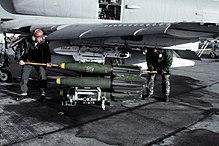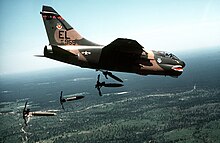Snake Eye Bomb
Since 1964, the unguided high- explosive bombs (Low-drag general-purpose bomb; LDGP) of the type Mk.81 to Mk.83 , which have a tail cone with air brake surfaces, have been designated as snake eye bombs ( German snake eye bomb ) .
use
The Snake Eye bombs are the most widely used and sold US bombs. The bombs are used by all NATO countries and other countries.
In the Vietnam War the bombs were beside firebombs used most often. They are mostly used to attack structures, but also armored and unarmored targets over a large area.
Working principle
The special Mk.15 rear set has four air brake surfaces that fold out in a cross shape, which, due to the greatly increased air resistance, ensure a slower rate of fall. The bombs are equipped with a brake tail unit for dropping from a low height. This is intended to reduce the risk of damage to the aircraft being dropped. The fragmentation effect of the bomb shell has the largest share in the destructive power. In the meantime, the Snake Eye are no longer in use by the US armed forces, as they have been replaced by the balloon-like BSU-85 / B "AIR" (Air Inflatable Retarder) delay kits for the Mk.81-83 series.
Models
| bomb | Weight class (lb) | Weight in kg | Explosives in kg | Length in m | Diameter in cm |
|---|---|---|---|---|---|
| Mark 81 "Snake Eye" |
250 | 113 | 44 | 1.18 | 22.8 |
|
Mark 82 "Snake Eye" |
500 | 227 | 82 | 2.21 | 27.3 |
| Mark 83 "Snake Eye" |
1000 | 454 | 202 | 3 | 35.7 |
Web links
- Mk80 series bombs (airpower.at)
- Introduction to the topic (globalsecurity.org)


